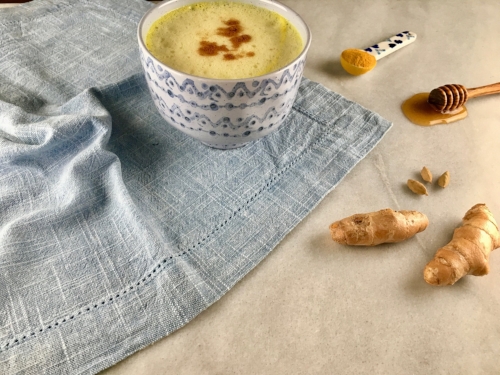Ayurveda Self Care for Fall
Ayurveda has six seasons rather than the four we know of in the western world. They are known as Shishira (winter), Vasanta (spring), and Grishma (summer) in Uttarayan and Varsha (monsoon), Sharata (autumn), and Hemanta (late autumn). We are currently in Sharata or sharad until mid November.
Sharad or Autumn is known as the season of transition and there is increased Vata dosha in the atmosphere which carries into winter as well. Vata brings increased air and prana (subtle life force) as light, dry, subtle,cold, rough qualities which are apparent in nature as well as inside our bodies and minds. Those with a Vata dominant constitution may find themselves feeling extra scattered, forgetful, anxious, have difficulty remembering things, feel flighty and even fearful due to the increased Vata in their system.
In Ayurveda a daily and seasonal routine is a key component of self care and for maintaining optimal health, the seasonal routine is referred to as Ritucharya and the daily routine is Dinacharya. A few simple techniques in our daily practice will help prepare our bodies for winter and deep rest, supporting our immune system by insuring our agni (digestive fire) stays strong and burns clean.
Dinacharya-
As the hours of available sunlight decrease it is often challenging to wake up early especially for those who are Vata and Kapha dominant, for this season Ayurveda suggests we still aim to wake up before 6:00 am.
Between 2:00 am - 6:00 am is Vata time of the day so when we arise between those hours it means we carry the lightness of Vata energy throughout the day. This is also the ideal time to do spiritual practices because there is deep solitude in the atmosphere at that time and it Vata allows us to connect to the subtle world much faster and easier. The later you rise from from 6:00 am you will go into the Kapha time of day (6:00 am -10 am) which means likely feeling more tired, sluggish and heavy. If you are like me and need that extra sleep you can push it a little extra to 7 or 7:30 am especially on those freezing, dark, rainy days
As usual you want to wake up and stretch the body, avoid reaching for your phone until your morning practice is complete and instead opt for starting with a few quiet moments of sitting up in bed and having gratitude for the new day, send blessings out to the world and write down your intention for the day. I like to write 3 personal and 3 professional goals which help me have a focus for the day and reduce anxiety which comes very easily during this season as a result of Vata disturbance.
Morning elimination can be a challenge because we tend to indulge in heavier foods, more sweets and late night eating during this season so ensure that you are supplementing with triphala and/or amla (better for those with high Vata) every evening before bedtime.
After elimination and brushing your teeth use a tongue scraper to get rid of the ama (toxins) from undigested food (and emotions) this also helps kindle the digestive fire followed by a cup of hot water with lemon, you can add ginger if you feel you need extra tummy support. Our self care has a very strong focus on the stomach and digestive system because it is the second brain of the body and has the greatest impact on our health and well-being.
Abhyanga is also at the core of daily ayurveda self care in every season, this is a full body oil massage done prior to bathing. It helps to break up the toxins under the skin and draw out impurities from the deeper tissues. Abhyanga restores the lustre and softness in the skin, lower anxiety and stress, increase blood flow and circulation, lubricates joints, stimulates internal organs, cultivates self love and connection to the body amongst many other benefits. You can use warmed, cold pressed and organic sesame oil for Vata and Kapha dosha, Pitta should can do a mix of sesame with sunflower or coconut.
Sadhana is the “means of accomplishing something” or a daily spiritual practice, for me this is essential in every season because it provides us with vital mental hygiene, clarity, joy, focus and harmony. Cultivating a sadhana practice can take some time and experimenting to find what works best for you, you can start with basic pranayama (breathing techniques), asana (physical yoga) and sitting for at least 5- 20 minutes of meditation. A fall pranayama and yoga practice should be invigorating yet gentle, grounding and warming and can include Bhastrika, Nadi Shodana (alternate nostril breathing), Kapalbhati, sun salutations and this Vata balancing yoga sequence. We still do have sunshine in the Vata months so be sure to get outside and take in the morning rays when possible to help alleviate Vata disturbance and seasonal affective disorder.
Diet-
A proper seasonal diet with fresh, organic, easily digestible and nourishing foods for each dosha is essential achieving optimal health but contrary to modern belief system of “you are what you eat” in Ayurveda, “you are what you digest” hence our focus on strengthening agni and purifying the digestive system.
Autumn calls for a Vata balancing diet that keep the digestive system liquid and warm which means nourishing cooked foods with plenty of warming and stimulating spices such as black pepper, ginger, turmeric, cinnamon garnished with ghee. Avoid cold,frozen raw, processed,heavy and oily foods as they dampen the digestive fire; favour sweet, salty and sour taste instead of bitter,pungent and astringent. Also limit intake of caffeine which is a big Vata aggravator, choose warm herbal teas, CCF tea, hot water with lemon + ginger instead. Favour sweet fruits : Apples (cooked), avocados, bananas,dates,figs, grapes, lemon, mango,cooked pear, papaya, oranges/tangerines, soaked raisins & prunes. Use plenty of cooked, watery vegetables such as: Asparagus,avocado, beets, carrots, okra, pumpkin, summer & winter squash, sweet potatoes, yams,zucchini. Vata pacifying Grains: Amaranth, durham, cooked oats, quinoa, all rice, seitan, sprouted wheat.
Bedtime:
Power off electronics at least 1 hour before bedtime to reduce activity in the mind which is aggravating to Vata. Create a consistent bedtime of at least 10 pm,( latest 11/11:30) any later will push you into Pitta time which brings a second burst of energy pushing the mind & body into activity mode and making it difficult to get restful sleep. Bathe if possible or wash your feet with warm water to remove the days energy and oil them with sesame mixed with a few drops of lavender or sandalwood oil for a sound sleep.
Practice having a nightly meditation practice which can consist of letting go of anything you feel you did not achieve, forgiveness and gratitude for what you did cultivate that day. This helps settle the mind as the tendency is to be stuck on what we did not do which can create a habitual operating pattern resulting in anxiety, anger or depression so support your mind, body and spirit by learning to let thoughts and emotions flow.
A warm and yummy nighttime drink such as herbal tea or haldi doodh with ghee is also helpful is settling vata dosha, lubricating the digestive tract and preparing the body for a restful sleep. 1 tsp ghee can also be taken internally with hot water for Vata and Pitta dominant people, Kapha can have a very small amount of ghee and add some ginger/honey which helps Kapha to assimilate the ghee.
Warming Hug Haldi Doodh / Golden Mylk
1 Cup of your choice dairy-free mylk or whole fat organic milk
1/2- 1 tsp fresh grated turmeric or organic turmeric powder ( I love Diaspora Co. haldi)
1/8 tsp of nutmeg (natural sleep aid)
pinch of cinnamon
1/2 tsp fresh grated ginger
pinch of black pepper
1 tsp ghee
Optional: raw organic honey or vegan honey like Bumble Bloom Cardamom to sweeten or blend milk with soaked dates for an extra delicious treat. When using honey do not add to the mylk when it is hot, wait until it has cooled to drinkable temperature as heating honey makes it toxic for consumption.
Optional: You can add Ashwagandha root powder which is a powerful Ayurvedic adaptogen herb that helps with adrenal fatigue, lowers cortisol levels, stress and anxiety, reduces symptoms of depression and improves memory function.
Warm your mylk/milk on the stove top on medium heat and add all spices except honey & ghee, bring to a boil 3 x, this helps take out the Kapha element in the milk making it easier to digest. Pour into your favourite mug and stir in your ghee, if you are using dates you can carefully blend milk while it’s hot with 1-3 pre-soaked dates or wait until its cool to add your raw honey. Vegan honey can be added right away as it not affected by heat.
Remember that in Ayurveda we use the opposite as medicine and like increases like, so when you observe your body and mind reacting to certain elements simply look for the opposite as a pacifying remedy. Vata thrives on being warm, nourished, grounded,treated with love, comfort, softness and sweetness. Create a beautiful relationship with the seasons and be well.
xo











